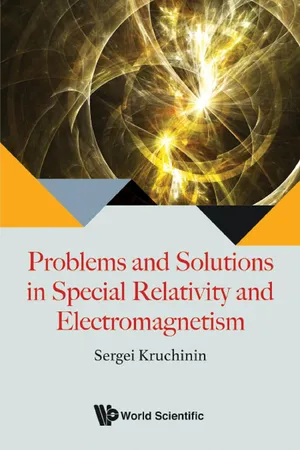
- 148 pages
- English
- ePUB (mobile friendly)
- Available on iOS & Android
Problems and Solutions in Special Relativity and Electromagnetism
About this book
-->
Field theory is an important topic in theoretical physics, which is studied in the physical and physico-mathematical departments of universities. Therefore, lecturers are faced with the urgent task of not only providing students with information about the subject, but also to help them master the material at a deep qualitative level, by presenting the specific features of general approaches to the statement and the solution of problems in theoretical physics. One of the ways to study field theory is the practical one, where the students can deepen their knowledge of the theoretical material and develop problem-solving skills. This book includes a concise theoretical summary of the main branches of field theory and electrodynamics, worked examples, and some problems for the student to solve.
The book is written for students of theoretical and applied physics, and corresponds to the curricula of the theoretical courses "Field theory" and "Electrodynamics" for physics undergraduates. It can also be useful for students of other disciplines, in particular, those in which physics is one of the base subjects.
-->
Request Inspection Copy
--> Contents:
- Foreword
- Introduction
- Vector and Tensor Analyses
- Elements of the Special Theory of Relativity
- Relativistic Mechanics
- Constant Electric and Magnetic Fields in Vacuum
- Electromagnetic Waves
- Field of Moving Charges
- Emission of Electromagnetic Waves
-->
--> Readership: Teachers and students of theoretical physics at advanced undergraduate level. -->
Electrodynamics;Special Relativity;Field Theory Key Features:
- "Field theory" is an important course from the cycle of subjects of the theoretical physics, which is studied in the physical and physico-mathematical faculties of higher schools
- Each chapter has a brief introduction to the theory, followed by some examples, then problems and finally solutions. Thus the book is "self-contained" in that sense
Frequently asked questions
- Essential is ideal for learners and professionals who enjoy exploring a wide range of subjects. Access the Essential Library with 800,000+ trusted titles and best-sellers across business, personal growth, and the humanities. Includes unlimited reading time and Standard Read Aloud voice.
- Complete: Perfect for advanced learners and researchers needing full, unrestricted access. Unlock 1.4M+ books across hundreds of subjects, including academic and specialized titles. The Complete Plan also includes advanced features like Premium Read Aloud and Research Assistant.
Please note we cannot support devices running on iOS 13 and Android 7 or earlier. Learn more about using the app.
Information
Section 1
Vector and Tensor Analyses
1.1.Vector and tensor algebras.
Transformation of vectors and tensors







Table of contents
- Cover Page
- Title
- Copyright
- Foreword
- Introduction
- Contents
- Section 1. Vector and Tensor Analyses
- Section 2. Elements of the Special Theory of Relativity
- Section 3. Relativistic Mechanics
- Section 4. Constant Electric and Magnetic Fields in Vacuum
- Section 5. Electromagnetic Waves
- Section 6. Field of Moving Charges
- Section 7. Emission of Electromagnetic Waves
- References